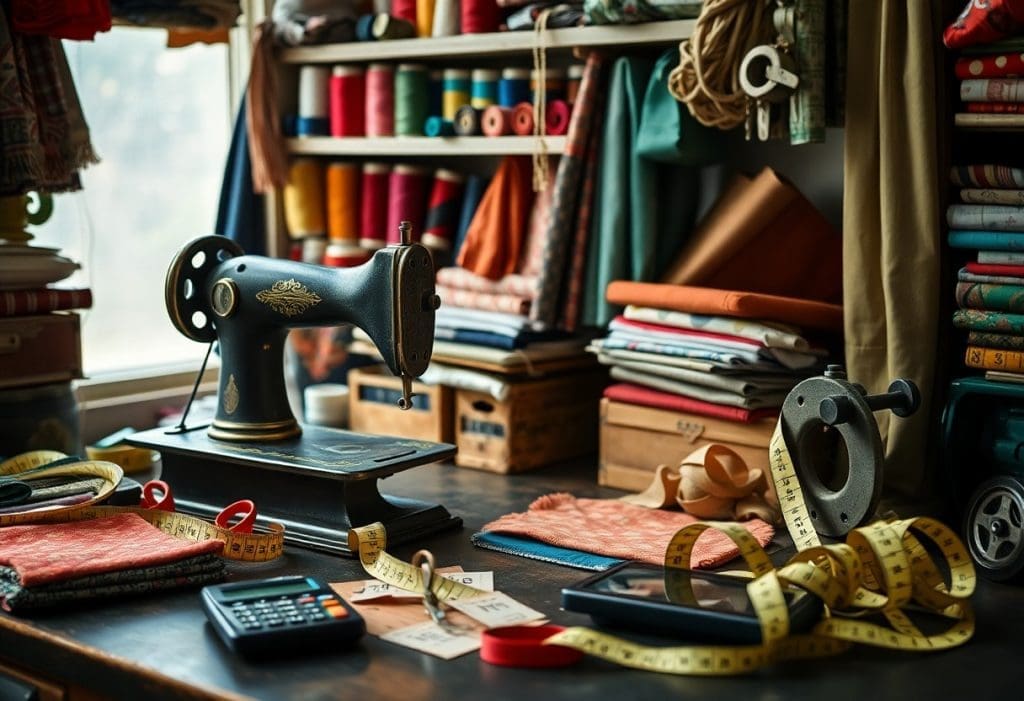Let’s get right to the point: Is sewing an expensive hobby? Not necessarily!
From sewing machines to fabric and tools, the initial investments can seem daunting.
However, with a little planning and knowledge, you can find ways to keep your spending in check while still enjoying the many rewards of sewing.
Join us as we explore the various aspects of sewing costs, so you can decide if this hobby is right for you without breaking the bank.
The Initial Investment: What’s in Your Sewing Kit?
To get started with sewing, you’ll need to consider the initial investment in your sewing kit.
This includes all the tools and supplies you’ll need to make your sewing journey enjoyable and efficient.
While it might seem daunting at first, quality items will save you money in the long run and enhance your sewing experience.
Essential Tools and Supplies
Although you could just buy a pre-made sewing kit, you still need to ensure the kit you buy has all of the items you will need.
Here’s a list of what to look for:
- Sewing machine
- A variety of needles
- Thread
- Scissors
- Measuring Tape
- Pins
- Fabric
These items may seem simple, but they form the foundation of your sewing projects, making it easier to create beautiful garments and home decor.
Fabric Costs: Finding the Right Material
What’s important to consider when it comes to fabric costs? Start by paying attention to the type and quality of material you choose.
Fabrics can range from inexpensive for things like cotton and polyester to luxurious, such as silks and wools.
Be sure to understand your project requirements. This will help you find the right balance between cost and quality.
Explore local fabric stores, online retailers, or even thrift shops for unique materials. Look out for sales, discounts, and fabric remnants, as these can save you a lot of money.
As you gain experience, you’ll develop a better eye for choosing fabrics that suit your style and budget, making sewing a rewarding and cost-effective hobby.
Ongoing Expenses: Keeping Your Hobby Alive
Assuming you’ve embraced sewing as a hobby, you should be aware of the ongoing expenses that come with it.
The costs of fabric, notions, and tools can add up over time. Be sure you have a budget available for this purpose, so there are no surprises along the way.
Think of these expenses as investments into your creative journey, allowing you to expand your skills and explore new techniques along the way.
Patterns and Inspirations
Behind every beautiful creation is a pattern or inspiration, which often comes at a price.
While many free patterns are available online, the quality patterns are usually designed by professionals.
Premium or limited availability patters are a sound investment for multiple reasons, the best of which is an endless flow of fresh ideas. And you won’t be using the same tired free patterns everyone else is leaning on.
Maintenance and Upgrades for Your Machine
If you want to prolong the life of your sewing machine, you should have it serviced regularly. You’ll also get better and more consistent results with it if you keep it running in tip top shape.
At some point, you might want to upgrade your machine with new features to enhance your sewing experience. That could set you back several hundred dollars, depending how fancy of a machine you move to.
Meanwhile, however, it will offer you more capabilities, so you can tackle more complex projects.
Ultimately, these enhancements will not only improve your sewing efficiency but also inspire you to push your creative boundaries.
The Hidden Costs of Sewing
We already covered some of the real costs, such as a sewing machine, patterns, fabric, etc. But there are a couple of areas you should know about.
Time Commitment: A Valuable Resource
The time you invest in sewing is as important as the money you spend.
Each project takes time, from selecting fabrics to sewing and finishing touches. This commitment can impact your daily schedule, especially if you juggle other responsibilities.
It’s worth considering how this time investment fits into your life and whether it brings you joy and satisfaction.
If you know you can make it work, welcome to sewing!
Storage Solutions for Your Supplies
Sewing requires a lot of supplies, and you will need to plan for managing those supplies to avoid a cluttered workspace.
The answer is a proper storage system, which not only helps keep your supplies organized but also ensures you can easily find what you need when inspiration strikes.
From bins and baskets to rolling carts and wall-mounted systems, the right storage solutions can make a significant difference in your sewing experience.
By investing time in creating a neat and accessible storage area for your fabrics, threads, and tools, you’ll save yourself future frustration and wasted time.
An organized space fosters creativity and can make the sewing process more enjoyable, letting you focus on your projects without distractions.
Budget-Friendly Tips for Sewists
Many sewists worry about the costs associated with their craft, but you can easily keep expenses down with a few smart strategies.
Consider these budget-friendly tips:
- Use remnants and scraps for smaller projects
- Borrow or rent tools instead of buying them
- Join local sewing groups to share supplies and patterns
- Look for sales and coupon
These are some great ways to get started at minimal investment. Perhaps you can just try it out first and later invest if you love it.
Thrifting for Fabrics
Between thrift stores, garage sales, and estate sales, you can discover a treasure trove of fabric at a fraction of retail prices.
Many people donate or sell their unused materials, allowing you to score high-quality fabric and unique patterns for less.
Don’t overlook old linens and clothing items, as they can provide excellent fabric choices for your sewing projects.
DIY Hacks and Upcycling
Ah, Do-It-Yourself (DIY) hacks…those can really reduce costs.
You can repurpose old clothing, using its fabric for new creations, or adjust patterns to accommodate what you already have on hand.
By creatively upcycling materials, you can not only save money but also express your personal style.
Think about turning old jeans into bags or transforming thrifted garments into fresh outfits.
Each project can be a unique expression of your creativity while minimizing waste and expenses.
The Joy of Sewing: Is It Worth the Spend?
After investing in sewing supplies and equipment, many find themselves questioning whether the joy of sewing makes it all worthwhile.
The truth is, the ability to create something unique with your own hands can be incredibly fulfilling.
Every stitch can bring satisfaction as you see your ideas come to life, making the monetary investment feel small in comparison to the happiness it brings.
Value Beyond Money
Above the initial costs, sewing offers value that extends far beyond mere dollars and cents.
You develop new skills, boost your creativity, and cultivate mindfulness while engaging in this hands-on activity.
And it’s also great for providing a sense of accomplishment. It’s just a lovely hobby.
Is Sewing an Expensive Hobby? Not Always!
While it CAN be expensive, sewing can fit various budgets, making it a hobby that you can tailor to your needs.
By choosing your materials wisely and prioritizing tools, you can enjoy this rewarding pastime without breaking the bank.
Whether you decide to invest in high-quality fabrics or stick to affordable alternatives, the joy of creating something beautiful is what truly matters.
So go ahead, embrace your creativity and enjoy every stitch of your sewing journey!



